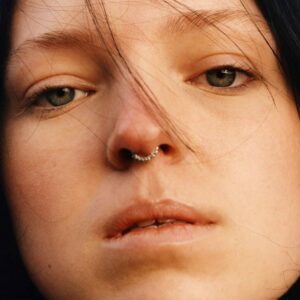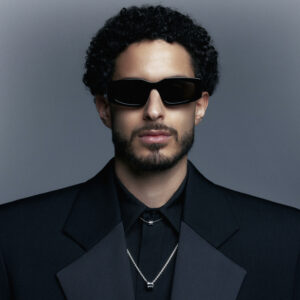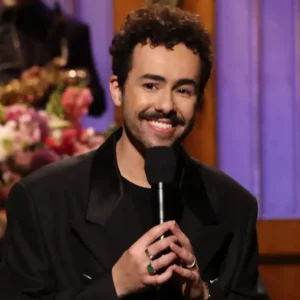“I always work with the present natural light of the space. This is how this moment is produced and this is how I want to present it. I don’t want to manipulate anything,” Egyptian photographer kafrawy muses, his words echoing his philosophy of capturing life as it unfolds, unscripted and unembellished. His method of holding onto the moment just as it presents itself, without the veneer of manipulation, has come to be the defining signature of his work.
A staple in Cairo’s music scene, kafrawy tells it like it is. His camera, a silent observer, records the city in its most genuine form. “My biggest thing has always been involvement and showing up,” he says. From the frenzied energy of the crowds, to the quiet vulnerability of backstage moments, kafrawy’s lens has captured it all.

“Before hip-hop blew up in Cairo, the dominant sounds and images were not representative of me or what I like,” he shares. His photographs are a visual narrative of Cairo’s art and culture scene, a chronicle of its evolution and growth. But more than that, they are a reflection of his own journey and lived experiences. “I had the sort of desire to, on a very personal deep level, remember that I had this experience growing up,” he says.
For kafrawy, photography wasn’t a career choice; it was instinct. “I always had an interest in pictures and images and films and visuality or movement,” he shares. His journey into photography began as a personal endeavor, driven by an innate curiosity and desire to capture the world as he saw it. His academic background in anthropology and film only fueled this interest, teaching him to observe and analyze, to understand the context and significance of each moment. This led him to view photography not just as a hobby, but as a form of research and documentation, a way to explore and understand the world around him.

His entry into this world was as organic as his approach to it. “There was a nice phase where I would go to parties with my friends. I had a photographer friend in my shela and I used to go with her and capture some stuff with my phone,” he says. This laid-back beginning set the tone for kafrawy’s style: prioritizing the story and emotion behind each image over technical perfection.

He found himself drawn to electronic and hip-hop parties, the vivacious energy of the crowds, the raw talent that was just beginning to make its mark. “It was a really exciting period. Wegz was coming up. Shabjdeed was in Cairo,” he remembers. Underground scenes were bubbling to the surface, future superstars were stepping into the limelight, and new subcultures were taking shape. “The rap scene was just about to blow up,” he recalls, his eyes lighting up at the memory. “I wanted to document something I saw was valuable.” He felt the cultural shifts, the seismic changes. He was compelled to frame these moments, not just for himself, but for everyone riding the wave.
His words transport us to a time when Cairo’s music and fashion scenes were on the cusp of a major breakthrough. The year was 2018 or 2019 – Cairo was electric, the city was buzzing with a newfound energy. Local brands like UNTY were making waves, and kafrawy, then just a student, was in the eye of the storm. “Looking at fashion, looking at music, growing up looking at Shabaab international, looking at all of these brands at the time, I knew it was a really pivotal moment,” he shares.

“There weren’t many images of music and subculture in an invested, dedicated and continuous way in Cairo,” kafrawy reflects. “Not many people were taking pictures at, specifically, the underground electronic parties. And not many people were doing the sort of Lo-Fi DIY kind of image production. They were very commercial and overproduced,” he explains. “I was seeing a surge in more of a sub-DIY and Lo-Fi and punk, aggressive, in your face, honest, photography. I don’t think I added more, but I honed in on a certain aesthetic and I’ve been working on that and trying to sculpt of visual identity – a sort of look that is mine, that comes from a generation of people who are fed up with this overproduction, overdoing and overspending.”

He tips his hat to the legends, Fotometro and Tarek Effat, who he says paved the road for him. “They were both really big inspirations in terms of really being in the spaces, really meeting the artists, showing you how it’s like. They pioneered this transition from overproducing and commercial to okay, I’m just showing up with my camera and taking pictures of what it’s like,” he shares.
kafrawy’s initial foray into photography was marked by a raw and aggressive style, mirroring the frenetic energy of the parties he frequented. “A lot of my favorite pictures, I was hit by someone from the crowd or the camera was shaken or I had a drink spilled on me – in the pit,” he recalls with a hint of wistfulness.

His photographic approach is intimate and all-encompassing. “In the crowd, not in the studio,” kafrawy reaffirms. He doesn’t just observe from the sidelines, he participates in the collective, shared experience of the moment. “It’s about reminding the crowd of their experience in the moment instead of hero-ising or celebrating the artists,” he says.
As kafrawy dived even deeper, his work began to evolve. His initial, aggressive, in-the-heat-of-the-moment photos, snapped amid the kinetic energy of the crowd, gradually gave way to more intimate, still images that peeled back the curtain on the artists’ world behind the scenes. “I started within the crowds but then I began finding myself in rooms and spaces with the artists themselves and then on sets for music videos and that’s when I my pictures started becoming calmer and still,” he shares. He found himself drawn to the quieter moments, the raw vulnerability of the artists off-stage.

Yet, despite this shift in movement and composition, one element remained the same: his commitment to capturing the moment or subject as it is, without the embellishments or exaggerations that often pervade the world of photography. He sought to humanize the artists he photographed. “At the end of the day, they’re artists, so they do have a fragile inside that’s hungry, sad, confused, passionate, trying to figure out the world. So that’s what I want to show,” he explains.
“I think the best representation of that was my visit to Abyusif in his apartment,” he muses. “His apartment was a chaotic mess. We sat there and he’s like, honestly, this is how I live. I was like yeah, no, I don’t want to change a thing. Let’s take the picture. I used only the natural light and captured his space exactly how it was. We all loved how it turned out.”

In the end, kafrawy’s work is a visual diary, a personal archive of a city and its people, told through the lens of a keen observer. His photos are a nod to the artists, creators and dreamers who are shaping Cairo’s cultural landscape. And as he continues to capture Cairo, one photo at a time, he’s not just telling the city’s story, he’s living it.
Dive deeper into the creative heartbeat of MENA through our dedicated Art & Culture pages, here.












